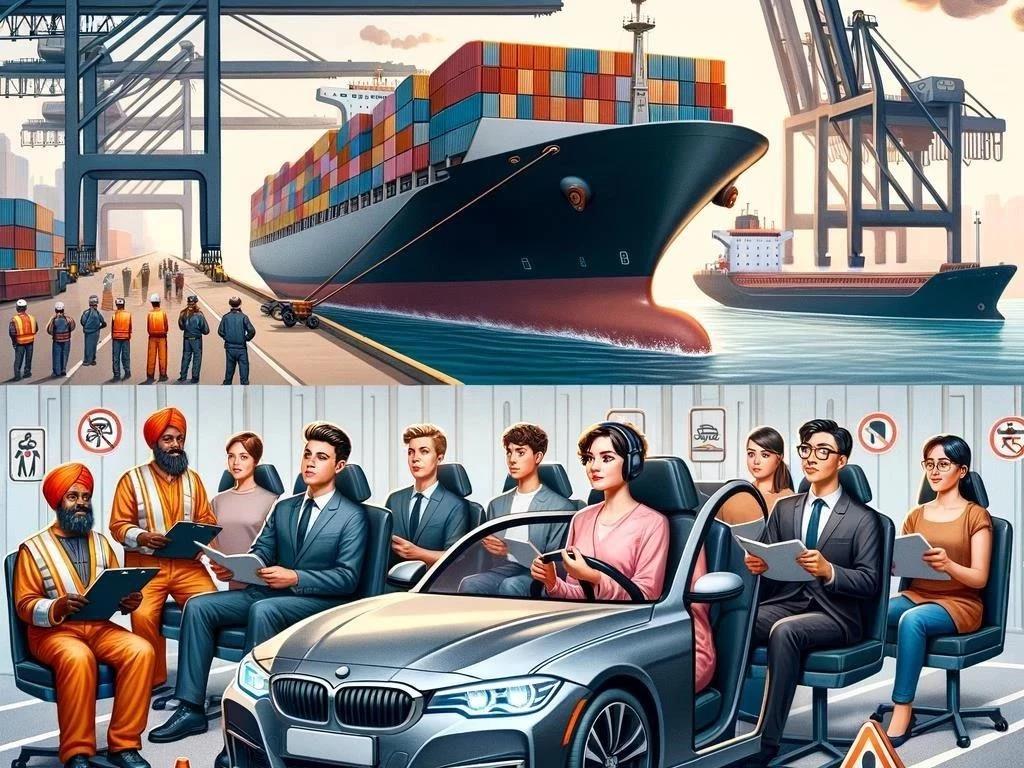Understanding Car Shipping and Driving
Deciding whether to ship a car or drive it involves evaluating logistics, shipping methods, cost comparison, and personal preferences to ensure optimal convenience and safety.
Both car shipping and driving offer unique advantages. Understanding these options helps you make informed decisions regarding vehicle transport, logistics, costs, and convenience factors involved.
What is Car Shipping?
Car shipping refers to the process of transporting a vehicle from one location to another using specialized logistics services. This method offers various transport options, including open and enclosed carriers, ensuring your vehicle arrives safely at its destination. Shipping companies provide transport quotes based on factors such as distance, vehicle condition, and delivery time. Customers often consider shipping costs against driving expenses, including fuel and maintenance. Additionally, car shipping eliminates concerns about breakdowns or driver safety during long-distance moves. When planning for car delivery, understanding different shipping methods and insurance coverage is crucial. This way, you can address budget considerations and ensure your vehicle is in good condition upon arrival, while safeguarding personal belongings during transit.
What Does Driving a Car Involve?
Driving a car involves several essential considerations, particularly during long-distance moves. Firstly, planning your route is crucial, as it affects travel time and mileage. You must account for fuel expenses, rest stops, and potential delays. Additionally, vehicle maintenance is vital, ensuring your car is in good condition to avoid breakdown concerns. Driver safety is paramount, so it’s important to follow traffic laws and be mindful of fatigue, especially on extended road trips. Moreover, keeping personal belongings organized within the vehicle is essential for convenience during the journey. Lastly, proper vehicle registration documentation should be readily available to avoid complications upon reaching your destination, enhancing the overall driving experience and ensuring a smooth transition.
Factors to Consider in Car Shipping vs. Driving
When deciding between car shipping and driving, consider logistics, shipping costs, vehicle condition, travel time, personal belongings, and overall convenience factors involved in the process.
Distance and Travel Time
When considering whether to ship a car or drive it, distance and travel time play significant roles. Long driving distances can lead to increased fatigue, making it essential to plan adequate rest stops. Driving can take considerably longer than shipping, especially for cross-country trips, where mileage and traffic conditions affect journey duration. Shipping companies typically provide estimated arrival times, allowing for more predictable scheduling. Additionally, the time saved by opting for car shipping can be used for other important tasks associated with relocation. However, if you enjoy road trips, driving might offer a unique experience. Ultimately, understanding your travel time requirements and how they align with your schedule can significantly influence your decision-making process.
Cost Comparison: Shipping Costs vs. Fuel Expenses
When evaluating whether to ship a car or drive it, a crucial factor is the cost comparison between shipping costs and fuel expenses. Car shipping fees vary based on distance, vehicle type, and chosen transport options. However, driving a car incurs fuel expenses, which fluctuate based on mileage and gas prices. Additionally, consider other costs, such as food, lodging, and possible vehicle maintenance during a road trip. While shipping may seem more expensive upfront, it can save time and prevent wear and tear on your vehicle. Conducting a thorough cost analysis, including all associated expenses, can help you determine the most budget-friendly option for your specific situation, ensuring informed decision-making.
Vehicle Condition and Maintenance
Assessing your vehicle’s condition is critical when deciding between shipping and driving. A well-maintained car is more likely to handle long-distance travel without issues. Before embarking on a road trip, consider necessary maintenance tasks, such as oil changes, tire checks, and brake inspections. Driving long distances can lead to increased wear and tear, raising concerns about vehicle reliability and potential breakdowns. In contrast, shipping your car eliminates these risks, as it allows for safe transport without adding mileage. Additionally, shipping services often provide insurance coverage, ensuring vehicle protection during transit. Ultimately, evaluating your vehicle’s condition and maintenance needs will significantly influence your decision on the most suitable transport method for your circumstances.
Transport Options for Vehicle Transport
When considering vehicle transport, explore various options including car shipping services, towing services, and car rental alternatives to meet your specific transportation needs effectively.
Shipping Methods Available
When considering car shipping, various shipping methods are available to suit different needs and budgets. Open transport is the most common and economical option, where vehicles are loaded onto a flatbed carrier, exposed to the elements. Enclosed transport, while more expensive, offers enhanced protection for luxury or classic cars, shielding them from weather and road debris during transit. Additionally, door-to-door service is available, allowing for convenient pickup and delivery at specified locations, saving time and effort. Terminal-to-terminal shipping is another option, where vehicles are dropped off and picked up at designated terminals. Understanding these shipping methods helps you choose the right approach, considering factors like vehicle condition, shipping costs, and desired level of protection.
Logistics of Car Delivery
The logistics of car delivery encompass various factors that ensure a smooth transportation process. Once you choose a shipping method, it’s essential to coordinate pickup and delivery locations, considering convenience and accessibility. Shipping companies often provide tracking systems, allowing you to monitor your vehicle’s progress during transit. Furthermore, arrival times can vary based on distance, route conditions, and chosen transport options. Proper documentation, including vehicle registration and insurance coverage, must be prepared in advance to avoid delays. Additionally, understanding the terms and conditions of the shipping agreement is crucial to address any potential issues. With effective logistics planning, you can ensure a hassle-free car delivery experience tailored to your needs.
Towing Services and Car Rental Alternatives
When considering transportation options, towing services and car rentals can provide viable alternatives to shipping or driving your vehicle. Towing services are ideal for short distances or if your car is inoperable, allowing you to transport it without adding mileage. Many companies offer flatbed towing, ensuring the vehicle is secured during transport. On the other hand, car rental can be a convenient solution if you need temporary transportation while your vehicle is shipped or repaired. Rental options vary widely, accommodating different budgets and preferences. Evaluating these alternatives based on your specific needs, budget considerations, and time constraints can help you make an informed decision regarding your vehicle transport strategy.
Safety and Insurance Considerations
Evaluating safety and insurance considerations is essential when deciding to ship a car or drive it, ensuring adequate protection for your vehicle throughout the process.
Driver Safety on Long-Distance Moves
Prioritizing driver safety is crucial during long-distance moves, as fatigue and distractions can significantly impact your ability to operate a vehicle safely. To enhance safety, plan your route carefully, identifying rest stops and accommodations along the way. Regular breaks are essential to combat fatigue, allowing you to recharge physically and mentally. Additionally, ensure that your vehicle is in optimal condition by conducting thorough maintenance checks before departure. Familiarize yourself with local traffic laws and road conditions to avoid surprises. It’s also wise to have an emergency kit in your vehicle, containing essentials like a first-aid kit, flashlight, and basic tools. Ultimately, thorough preparation and awareness contribute to a safe driving experience during long journeys.
Insurance Coverage for Shipping and Driving
Understanding insurance coverage is vital when deciding whether to ship a car or drive it. When shipping, most companies provide basic liability coverage, protecting against damages during transport. However, it’s recommended to verify the specifics of this coverage and consider purchasing additional insurance for added peace of mind, particularly for high-value vehicles. Conversely, when driving, ensure that your auto insurance policy is active and covers long-distance travel, as some policies may have restrictions. Additionally, consider the potential for accidents or breakdowns, which could lead to significant expenses without adequate coverage. Evaluating your insurance options thoroughly helps safeguard your investment, ensuring that you are financially protected regardless of your chosen transportation method.
Breakdown Concerns on the Road
Breakdown concerns are significant when contemplating whether to ship a car or drive it, especially for long-distance journeys. Driving increases the risk of mechanical failures, which can lead to costly repairs and extended delays. Factors such as vehicle age, maintenance history, and overall condition can influence the likelihood of a breakdown. To mitigate these risks, conduct a comprehensive inspection of your vehicle before embarking on a long trip, including checking the engine, tires, brakes, and fluid levels. Additionally, having a roadside assistance plan in place can provide peace of mind, ensuring you have support in case of emergencies. Ultimately, weighing these breakdown concerns against the reliability of shipping can influence your decision-making process.
Convenience Factors in Decision Making
Assessing convenience factors is essential when deciding between shipping a car or driving it, as this choice significantly impacts your overall experience and logistical planning.
Convenience of Car Shipping vs. Driving
The convenience of car shipping versus driving can significantly influence your decision-making process. Shipping your vehicle allows you to focus on other aspects of your move, such as personal logistics and settling into a new location. It eliminates the stress of long hours on the road, fuel expenses, and the need for overnight accommodations. In contrast, driving offers the flexibility to travel at your own pace and explore various routes, but it can be time-consuming and physically exhausting. Additionally, shipping often provides door-to-door service, enhancing overall convenience. Ultimately, evaluating your priorities and the importance of time versus exploration will help determine which option best suits your lifestyle and needs during this transition.
Personal Belongings and Vehicle Registration
When deciding whether to ship a car or drive it, personal belongings and vehicle registration play vital roles in your planning process. Driving allows you to keep essential items within easy reach, enabling a more comfortable journey. However, it’s important to ensure that your vehicle is not overloaded, as this can affect safety and fuel efficiency. Additionally, you must have all necessary vehicle registration documents readily available, ensuring compliance with state laws during your travels. On the other hand, shipping your car requires careful packing of personal belongings, often necessitating separate arrangements for transporting these items. Evaluating how personal belongings and registration requirements fit into your overall logistics can greatly influence your final decision.
Destination Planning and Arrival Time
Effective destination planning and understanding arrival time are crucial for choosing between shipping a car or driving, ensuring a smooth transition and timely logistics throughout.
Planning Your Route: Mileage and Travel Time
When deciding to ship a car or drive it, careful planning of your route is essential to understanding mileage and travel time. Driving requires you to map out the most efficient path, considering factors such as traffic patterns, road conditions, and available amenities along the way. Estimating travel time can help you schedule rest stops and overnight stays, ensuring a manageable journey. Additionally, longer drives increase fuel expenses and wear on your vehicle, leading to potential maintenance concerns. Conversely, shipping your car provides a more predictable timeline since shipping companies typically offer estimated delivery dates. Ultimately, understanding these aspects will help you choose the most suitable transportation method based on your unique circumstances and preferences.
Budget Considerations for Each Option
When weighing the decision to ship a car or drive it, budget considerations are paramount. Shipping costs can vary based on distance, vehicle type, and chosen transport methods, often leading to considerable expenses. However, these costs may include insurance coverage and peace of mind, as your vehicle is protected during transit. In contrast, driving incurs fuel expenses, food, lodging, and potential maintenance costs, which can accumulate quickly, especially on long journeys. Additionally, driving adds mileage to your vehicle, potentially impacting its resale value. It’s crucial to conduct a thorough cost comparison, factoring in all possible expenses for both options, ensuring that your final decision aligns with your financial situation and preferences for convenience and safety.
Ultimately, the decision to ship a car or drive it hinges on personal preferences, budget considerations, and logistical factors that best suit your unique circumstances.
Final Thoughts on Shipping vs. Driving
When deciding between shipping a car or driving it, consider your individual needs and circumstances. Shipping offers convenience and minimizes wear on your vehicle, making it an appealing option for long-distance moves. It allows you to focus on other aspects of relocation without the stress of a lengthy road trip. Conversely, driving provides flexibility and the chance to experience the journey, but it can lead to unforeseen challenges such as fatigue, breakdowns, and added expenses. Ultimately, weighing the pros and cons of each option—considering factors like budget, time, vehicle condition, and personal preferences—will help you make a well-informed decision that aligns with your goals and ensures a smooth transition to your new destination.








